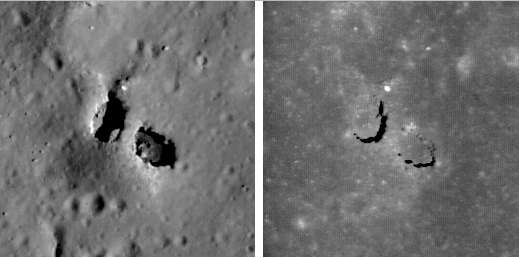Post by Hill on May 16, 2015 21:24:22 GMT
Quote:
Natural bridges have been found on the moon for the first time in images taken by a high-resolution camera aboard NASA's Lunar Reconnaissance Orbiter.
Students scrutinising the camera's images have spotted two natural bridges on the moon's far side. The larger bridge measures 20 metres long and 7 metres wide, while its smaller neighbour is about half that size.
Unlike natural bridges on Earth, which form largely by erosion from wind and water, these lunar bridges probably formed as a result of an impact in the last billion years, says Mark Robinson, a planetary geologist at Arizona State University in Tempe and principal investigator for LRO's camera.
You can find much more at the LROC PAGE

Left shows the bridge when the Sun is 42° above the horizon
and the right is the same
area when the Sun is 80° above the
horizon (near noon). M113168034R on the left,
M123791947L
on the right, both are 128 meters across, north is up.
[NASA/GSFC/Arizona State University].
The NASA folks have the following speculative idea of the formation which does involve molten rock - but not from a volcano.
Quote:
How did this oddity form? The impact melt deposit on the north rim of King crater is over 15 km across and was emplaced in a matter of minutes as the crater grew to its final configuration.
The impact melt that was thrown out of the crater pooled on the newly deposited ejecta and must be many tens of meters thick, allowing its interior to stay molten for a long time. As the local terrain readjusted after the shock of the impact, the substrate of this massive pool of melt was jostled to some degree. Local pressures built up and the melt moved around under a deforming crust. You can see that the south end of the bridge extends from a small local rise, shaped something like a blister. Perhaps some melt was locally pushed up forming the rise, then the magma found a path to flow away, leaving a void which the crusted roof partially collapsed? Right now we do not know for certain the details of how the bridge formed, however, the LROC team is processing stereo images into topographic maps to aid scientists in determining exactly what took place on this fascinating melt sheet.
The natural bridge should be visible in THIS IMAGERY
_________________________
Natural bridges have been found on the moon for the first time in images taken by a high-resolution camera aboard NASA's Lunar Reconnaissance Orbiter.
Students scrutinising the camera's images have spotted two natural bridges on the moon's far side. The larger bridge measures 20 metres long and 7 metres wide, while its smaller neighbour is about half that size.
Unlike natural bridges on Earth, which form largely by erosion from wind and water, these lunar bridges probably formed as a result of an impact in the last billion years, says Mark Robinson, a planetary geologist at Arizona State University in Tempe and principal investigator for LRO's camera.
You can find much more at the LROC PAGE

Left shows the bridge when the Sun is 42° above the horizon
and the right is the same
area when the Sun is 80° above the
horizon (near noon). M113168034R on the left,
M123791947L
on the right, both are 128 meters across, north is up.
[NASA/GSFC/Arizona State University].
The NASA folks have the following speculative idea of the formation which does involve molten rock - but not from a volcano.
Quote:
How did this oddity form? The impact melt deposit on the north rim of King crater is over 15 km across and was emplaced in a matter of minutes as the crater grew to its final configuration.
The impact melt that was thrown out of the crater pooled on the newly deposited ejecta and must be many tens of meters thick, allowing its interior to stay molten for a long time. As the local terrain readjusted after the shock of the impact, the substrate of this massive pool of melt was jostled to some degree. Local pressures built up and the melt moved around under a deforming crust. You can see that the south end of the bridge extends from a small local rise, shaped something like a blister. Perhaps some melt was locally pushed up forming the rise, then the magma found a path to flow away, leaving a void which the crusted roof partially collapsed? Right now we do not know for certain the details of how the bridge formed, however, the LROC team is processing stereo images into topographic maps to aid scientists in determining exactly what took place on this fascinating melt sheet.
The natural bridge should be visible in THIS IMAGERY
_________________________
